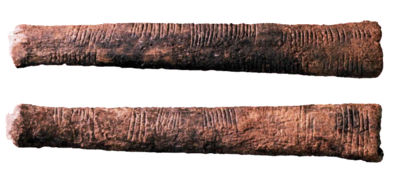Ishango bone
2008/9 Schools Wikipedia Selection. Related subjects: Archaeology
The Ishango bone is a bone tool, dated to the Upper Paleolithic era, about 18000 to 20000 BC. It is a dark brown length of bone, the fibula of a baboon, with a sharp piece of quartz affixed to one end, perhaps for engraving or writing. It was first thought to be a tally stick, as it has a series of tally marks carved in three columns running the length of the tool, but some scientists have suggested that the groupings of notches indicate a mathematical understanding that goes beyond counting.
The Ishango bone was found in 1960 by Belgian Jean de Heinzelin de Braucourt while exploring what was then the Belgian Congo. It was discovered in the African area of Ishango, which was centered near the headwaters of the Nile River at Lake Edward (now on the border between modern-day Uganda and Congo). The lakeside Ishango population of 20000 years ago may have been one of the first counting societies, but it lasted only a few hundred years before being buried by a volcanic eruption.
The artifact was first estimated to originate between 9000 BC and 6500 BC. However, the dating of the site where it was discovered was re-evaluated, and is now believed to be more than 20,000 years old.
The Ishango bone is on permanent exhibition at the Royal Belgian Institute of Natural Sciences, Brussels, Belgium.
Meaning of the tally marks
Mathematical calculations?
The three columns of asymmetrically grouped notches imply that the implement was more functional than decorative. The Ishango grouping may have been used to construct a numeral system.
The central column begins with three notches, and then doubles to 6 notches. The process is repeated for the number 4, which doubles to 8 notches, and then reversed for the number 10, which is halved to 5 notches. These numbers then, may not be purely random and instead suggest some understanding of the principle of multiplication and division by two. The bone may therefore have been used as a counting tool for simple mathematical procedures.
Furthermore, the number of notches on either side of the central column may indicate more counting prowess. The numbers on both the left and right column are all odd numbers (9, 11, 13, 17, 19 and 21). The numbers in the left column are all of the prime numbers between 10 and 20 (which form a prime quadruplet), while those in the right column consist of 10 + 1, 10 − 1, 20 + 1 and 20 − 1. The numbers on each side column add up to 60, with the numbers in the central column adding up to 48. Both of these numbers are multiples of 12, again suggesting an understanding of multiplication and division.
Lunar calendar?
Alexander Marshack examined the Ishango bone microscopically, and concluded that it may represent a six-month lunar calendar. Claudia Zaslavsky has suggested that this may indicate that the creator of the tool was a woman, tracking the lunar phase in relation to the menstrual cycle.
Similar finds
Several tally sticks predate the Ishango bone, and cuts on sticks or bones have been found worldwide. The Lebombo bone, a 37000-year-old baboon fibula was found in Swaziland. A 32000-year-old wolf tibia with 57 notches, grouped in fives, was found in Czechoslovakia in 1937.



